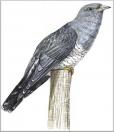Cuckoo - Cuculus canorus
Famous bird for its typical song and parasitic behaviour. It is easily recognised, particularly by its long tail and pointed wings.
There is no sexual dimorphism, but is not unusual for juveniles and females to go through a "red phase" , characterised by tawny hues of the plumage instead of grey.
There are marked behavioural differences; the males are exhibitionists and compete among themselves to please as many females as possible.
The latter do not sing like the males, but emit a loud trill like that of the Little Grebe (or Dabchick). The species comprises many different populations (or ecotypes), each adapted to a different habitat where they normally parasitise different hosts.
For example, marshland populations are specialised in parasitising the Reed Warbler (Acrocephalus scirpaceus), populations in the hills parasitise the Robin (Erithacus rubecula) and so on.
This specialisation is so rigid that even the colour of the eggs match those of the host species.
The female takes advantage of the characteristic pattern on her breast (narrow black cross stripes on a white background) which make her look like a bird of prey, to send brooding birds fleeing from their nests, then she lays her egg there at incredible speed.
Once the breeding phase is over, the adults precociously migrate to countries in tropical Africa followed in August or the first half of September at the latest by the young.




